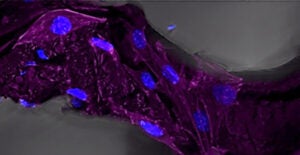A team of researchers from Boise State University, led by Eric Krueger and David Estrada, have published an article in the American Chemical Society’s Biomaterials Science and Engineering journal.
Titled “Graphene Foam as a 3-dimensional Platform for Myotube Growth,” it focuses on a study demonstrating the suitability of graphene foam as a scaffold for growing functional muscle tissue. Graphene foam is an emerging 3D version of graphene, a layer of carbon so thin it is considered 2-dimensional.
Ultimately, researchers hope that the unique properties of graphene and graphene foam can be used to regenerate 3-dimensional tissues and organs for implantation into the human body. Past studies have confirmed bone and cartilage growth on graphene foam, but this is the first known study of its compatibility with muscle growth.
“Not only did we demonstrate that extra cellular matrix proteins on graphene foam can enhance the differentiation of pluripotent C2C12 myoblasts, but we were able to verify muscle functionality by using the graphene foam itself as an electrode to stimulate the tissue,” said Krueger, postdoctoral research associate in the Micron School of Materials Science and Engineering. “You can actually see the movement of the cells and graphene foam as the muscle cells contract.”
The extracellular matrix consists of molecules secreted by cells within the connective tissues and organs of the body. Differentiation of pluripotent cells in response to their local environment is an area of intense research effort, and one that can make a significant impact to biomedical research and the treatment of connective tissue diseases through a regenerative medicine approach.
The study was a collaboration between three Boise State Ph.D. programs — in biomolecular sciences, electrical and computer engineering, and materials science and engineering — and used resources made available through the Biomolecular Research Center (BRC). The BRC is funded by a NIH Center of Biomedical Research Excellence (COBRE) in matrix biology award.
“This publication demonstrates the progress that can be made through collaboration based on a team approach to scientific research — this is the best way to accomplish such progress, and precisely the type of multidisciplinary project that the Biomolecular Research Center is established to support,” said center director Julia Oxford, a distinguished professor, program director and principal investigator of the COBRE award.
“These results help shed light on graphene’s ability to artificially engineer the chief components of the musculoskeletal system, which could have a major impact on understanding a variety of musculoskeletal disorders,” said assistant professor Estrada, coordinator of Boise State’s materials science and engineering graduate program and corresponding author on the paper.
Developing new bioscaffolds for tissue engineering, particular 3D scaffolds, will help advance our understanding of stem cell behavior in three-dimensional microenvironments. Such understanding could allow engineers and scientists to control the 3-dimensional growth and differentiation of stem cells in order to engineer biological systems.
Now, the group is working to exploit the full spectrum of graphene’s unique properties for tissue engineering.
“We think we can build on these results to investigate the fundamental chemistry of life while advancing towards clinical applications,” Estrada said. “Graphene has just begun to flex its muscles in the bioengineering domain.”

Raquel Brown: Confocal fluorescence microscope image of C2C12 myoblasts on graphene foam.
Authors are:
Eric Krueger (now at Lehigh University), Materials Science and Engineering
Nicole Chang, Materials Science and Engineering
Dale Brown, Materials Science and Engineering
Josh Eixenberger, Physics, Biomolecular Research Center, Biomolecular Sciences Ph.D. program
Raquel Brown, Biomolecular Research Center
Sepideh Rastegar, Electrical and Computer Engineering
Katie Yocham, Mechanical and Biomedical Engineering
Kurtis Cantley, Electrical and Computer Engineering
David Estrada, Materials Science and Engineering
Additional funding was provided by: Idaho INBRE Program, J. Murdock Charitable Trust, The National Science Foundation, The Idaho State Board of Education and Lori and Duane Stueckle
Article By: Sherry Squires